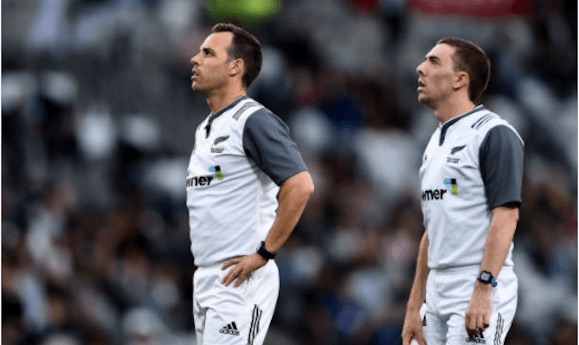Isn’t it fantastic that refs are blowing forward passes again, writes ZELIM NEL.
It’s been some years since rugby bosses tweaked the laws to legalise forward passes as part of their quest to sell the game as an attack-dominated, try-scoring shootout.
For a sports marketer, there’s nothing more crushing than a thrilling try being negated by pesky rules, like the one that is arguably most central to rugby’s unique offering.
The result is that ‘tries’ have been awarded from passes that blatantly carried the ball towards the tryline. Carnival sports consumers have reacted with the sought-after clicks, but it’s been nauseating for deep-rooted, lifelong fans who tune in for a traditional rugby contest.
Clearly, some referees have also had their fill of the malarkey. On Sunday, Blues No 8 Akira Ioane made a break up the right touchline at Eden Park, drew a defender and zipped the ball 20 metres inside to his brother Rieko, who streaked away for the try.
However, by the time the ball had completed the trip from Akira to Rieko, it had travelled more than five metres towards the Highlanders tryline. Ref Mike Fraser had a quick look at the replay and called play back.
Social media melted as the discussion dived into semantics around anatomical intricacies and ‘physics’, neither of which the sport’s founders ever factored into determining whether a pass had travelled forward.
Supporters of legalising forward passes justify their position by citing the irresistible impact of inertia.
Let’s just pretend for a second that an external force is the reason the ball travelled forward – where else do we accept that as an excuse for a lack of accuracy?
When a well-taken penalty attempt is pushed wide left by a crosswind, do the touch judges determine the wind was to blame and raise their flags? What about when inertia limits a tight forward’s ability to change direction and tackle a hot-stepping wing – must the speedster come back to where he would have been tackled and place the ball?
Why is it that these examples are deemed ridiculous, but when a ball is passed forward we are expected to accept that it is the result of forces the player could not compensate for?
The reality is that inertia is not primarily the reason why Akira’s pass was forward. The four key factors at play were the speed of the pass, the distance to the receiver, and the depth and speed of the receiver.
The bottom line is that if Rieko had been standing still at the time Akira passed the ball, the No 8 would have been able to draw on decades of passing experience to triangulate the distance and depth of his brother and hit that target with his pass. What put the ball on a forward flight pattern was the fact that Akira calculated where Rieko – travelling at speed – would be by the time the ball had travelled 20m.
During the roughly 1.5 seconds the ball was in the air, Rieko ran from around the Blues’ 45m to the Highlanders’ 41m mark. The ball was passed from the Highlanders’ 49.
Realistically, the only way to complete a pass of that speed in those circumstances, without it travelling forward, is for the receiver to check his depth or speed because Akira’s sights were set on Rieko, not a point on the field.
As shown by this incident, the fallacy that the receiver need only be behind the passer at the time of the pass is exposed the further the receiver is from the passer, and the faster he is running on to the pass, because the passer has to factor in the time that the ball is in the air.
Won’t this make it much more difficult to score tries? Absolutely!
But summiting Mount Everest wouldn’t be something you put on your CV if there was an elevator to the top. What makes tries so special is that they’re difficult to score. Turning a blind eye to forward passes devalues the feat and gnaws away at the fabric of the game.
Kudos, Mike Fraser – keep up the good work!




